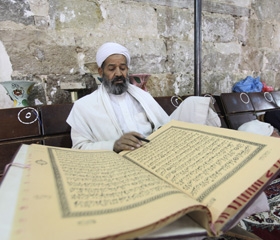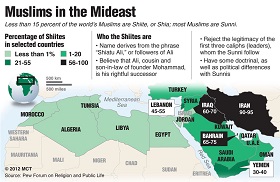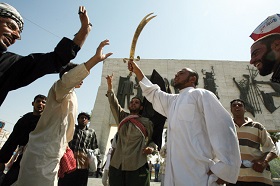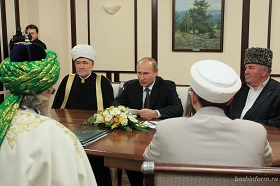Shiites and Sunnis: The Danger of Major War from Syria to Pakistan
Sayyidah Zaynab Mosque, Damascus, Syria
(no votes) |
(0 votes) |
PhD in Philosophy, Adviser to the director of the Russian Institute for Strategic Studies, Asia and Middle East specialist
Both the exodus of refugees and concerns over terrorism are on everyone’s lips today due to recent developments in the Middle East. However, there is another sensitive, but much less frequently discussed issue. The point at stake is that the conflict in Syria, which being not religious in nature, has often provoked hostility on religious grounds.
Both the exodus of refugees and concerns over terrorism are on everyone’s lips today due to recent developments in the Middle East. However, there is another sensitive, but much less frequently discussed issue. The point at stake is that the conflict in Syria, which being not religious in nature, has often provoked hostility on religious grounds.
In his speech at the opening of the International Conference on Syria in Montreux, Switzerland on January 22, 2014, Russian Foreign Minister Sergei Lavrov emphasized the fact that many Syrian Christians had started to leave the country. One phrase from his opening speech has certainly caught the attention of many people as well as specialists, “When it comes to renewed consideration of the Syrian crisis, intra-Islamic conflicts have become more and more dangerous. However, they cannot be allowed to escalate.” [1]
The War in Syria Only Helps Extremists
At issue here are disagreements between Shiite Muslims and Sunni Muslims. This split in Islam took place almost fourteen centuries ago, immediately following the death of the Prophet Muhammad. Nevertheless, history has seen periods of stability when different communities in different countries have lived together quite peacefully. On the other hand, every now and then conflicts occur too, and we are now witnessing again a surge of tensions in the Middle East.
Although in my opinion large-scale war between the Shiites and the Sunnis is not in the offing, the threat of it breaking out will dramatically increase if international mediators fail to stop the destruction in Syria.
Unlike many other countries (such as Tunisia, Egypt and Libya), the mosaic of religious and ethnic composition in Syria will have a profound impact on the alignment of forces in the Middle East should the regime in the country change dramatically.
Extremists perceive the situation in a quite simply way: the Shiite minority, which is being backed by Shiite Iran, has ruled the country for more than 40 years and is now opposed by the Sunni majority, supported by the Arab Sunni monarchies.
This simplistic view reflects only a small part of the picture. But while at the beginning the Syrian conflict had little to do with religion, we now see many examples of people being killed in the country just because of their “different” religious affiliation.
Today, danger lies in the fact that the escalating conflict is not limited to the territory of Syria. Given the geographic proximity, composition of the population and political instability, neighboring Iraq and Lebanon [2], who have their own long-standing similar problems, have become the first victims outside of Syria to suffer from the religious conflict. However, this religious problem is affecting not only these states, but also countries beyond the Middle East.
Shiites and Sunnis: Neighbors and Even Relatives
Unlike other countries the mosaic of religious and ethnic composition in Syria will have a profound impact on the alignment of forces in the Middle East should the regime in the country change dramatically.
In terms of size, Shiite Muslims are the minority, making up according to estimates 10 to 15 percent of the total population of Muslims [3]. There is little doubt that the Sunnis will continue to constitute the majority in the Muslim community of nearly one and a half billion people [4].
Nevertheless, Shiites are the majority (60 percent or more) in four states, namely Iran, Iraq, Azerbaijan and Bahrain.
Thus, of 34 million Muslims in Iraq, Shiites make up about 60 percent, while the number of Sunni Muslims, according to various estimates, varies from 20 to 30 percent [5]. Recently, the Shiites in Iraq fell from power.
Shiites also live in Saudi Arabia, Syria, Yemen, Lebanon, Turkey, Afghanistan, and Tajikistan [6]. In Pakistan, the Shiites make up from 13 to 20 percent, but since the population of the country is about 190 million people, they constitute a fairly big community [7].
Different communities settle quite often in neighboring villages or neighborhoods. As a rule, it is possible to single out places of predominant Sunni or Shia settlements, although not everywhere, and this proximity aggravates the danger of conflict even more. To cap it all off, there are mixed marriages when the children's father is a Sunni, while their mother is a Shiite, or vice versa. This kinship, however, is not always an antidote against religious animosity.
Who Is Sure to Go to Heaven?
Still, the current surge of hostilities between Shiites and Sunnis is not something abnormal, although it does have its own peculiarities. Shiites and Sunnis have been at odds before, with the history of differences arising in the Muslim community testifying to this better than anything else. Understanding this is essential for having a clear view of what is happening within Islam today.
As researchers note, “the Muslim tradition rests upon the hadith attributed to the Prophet Muhammad, according to which he predicted that his ummah would be divided into 73 sects, but only one, representing the majority of Muslims, would be saved.” [8]
With Muhammad's death at the age of 62 in Medina in the summer of 632 AD, the main split occurred in the Muslim community. Since none of Muhammad's sons survived into adulthood and the Prophet left behind no concept of supreme authority, bitter disagreements broke out over who should succeed him as leader of the Muslim community.
Part of the community insisted that the power should be transferred to the Prophet’s relative, namely his cousin and son-in-law Ali (Ali ibn Abi Talib), who was married to the Prophet’s daughter Fatima. Those who shared this idea about the succession process disputed the election of the Prophet’s companion Abu Bakr as the first caliph (successor) and formed a separate “group”. Shi'a is the short form of the historic Arabic phrase meaning “followers”, and adherents of this group are called Shiites.
At the same time, many early Muslims studied and recorded the sayings and actions of the Prophet Muhammad and the four Rightly Guided Caliphs, starting with Abu Bakr. An Arabic word “Sunnah”, meaning “habit” or “usual practice”, or “path” gave the name to adherents of Sunni Islam. Shiites, in contrast, believed that Muhammad's rightful successor was only Ali and his descendants in the male line, but not the caliphs.
. Radicals’ attacks have become more frequent in recent years, pushing their coreligionists towards in other regions.
Ali and his sons were killed. Mutual hostility took away the lives of other followers of the Prophet, both among the Shiites and the Sunnis.
The outward differences in the religious practice between Shiites and Sunnis are almost unnoticeable, although their interpretation and understanding of the history of Islam as well the fate of the world differ. Under normal circumstances, such differences do not lead to violent conflict, but an exacerbation of the struggle for power, money or natural resources can dramatically change the situation.
In my opinion, some of the ascribed differences between Sunnis and Shiites are hard to substantiate. Thus, some political analysts claim that Sunni Muslims are more loyal to their governments than Shiite Muslims. It is claimed that Sunni imams are more “tolerant towards authoritarian and unjust rulers” for fear that “society could crash down into the abyss of chaos and anarchy”, while Shiite Islam “on the contrary, presents itself as a resistance force standing on guard of justice and equality.” [9]
Perhaps, such statements are based on the experience of the revolution in Iran in 1979, but the developments that started in the Arab world in 2011, including the overthrow of regimes in Sunni countries, demonstrate that the citizens sooner or later claim their rights, regardless of religious affiliation.
Who Devised the Shiite Axis

Georgi Mirsky:
Nationalism, islamism … - What colors will
the arabs fly after their “spring”?
With the majority of its 80-million population professing Shi'ism, Iran is the key Shiite state.
In recent years, we often hear that in its striving for leadership, Iran has established the Shiite axis or the Shia Crescent, encompassing Iran itself, neighboring Iraq where Shiites have seized power, Alawite-dominated Syria (Alawites are a sect close to Shia) and the politically powerful Shia militia Hezbollah in Lebanon.
However, we can talk about the Shia Crescent only with a fair degree of reservation. It was not Iran that contributed for the rise to power of the Shiite majority in Iraq. In 2003, it was the United States and its allies that overthrew the regime of Saddam Hussein and his Arab Baath Socialist Party (“Baas”). Israel also set cautious hopes on establishing relations with Iraq after the fall of Saddam.
But stability has yet to be achieved. Such dramatic developments as desecration, explosions, murders, and kidnappings are gaining momentum in Iraq, Syria and Lebanon, just as they started some years ago in Pakistan and Afghanistan.
Religious Animosity as a Result of Instability
According to my observations, the relationship between communities in religious societies worsens every time there is some kind of disorder, irrespective of the latter’s reasons.
In Afghanistan and Pakistan, for example, for many years there have been acts of violence against not only Shiites or Sunnis, but representatives of other religious movements too, namely Christians and Sufis (adherents of the mystical dimension of Islam). And this has nothing to do with the events of the so-called “Arab Spring.” The reasons lie in the general instability, which reached a peak of crisis much earlier than in quieter Arab countries governed by authoritarian rulers.
Clashes between Shiites and Sunnis caused by the events in the Middle East are gaining momentum within the emigrant communities of Europe, the U.S. and even Australia.
Experience also shows that extremists kill adherents of other faiths first, and then their own brothers in faith, if their beliefs are somewhat different. Thus, in Asia today, the position of moderate leaders who favor a lower degree of religiousness in public life is becoming increasingly threatened.
Examples are not hard to find. In December 2007, the well-known Pakistani politician Benazir Bhutto was murdered. The author spoke to B. Bhutto shortly before her death and she admitted receiving threats. I had the chance to talk to Punjab Governor Salman Taseer in the Pakistani city of Lahore a few weeks before his assassination on January 4, 2011. He also spoke about the threat of religious extremism.
There are extremists in the ranks of both Sunnis and Shiites. Radicals’ attacks have become more frequent in recent years, pushing their coreligionists towards in other regions. Their actions have acquired a flavor of revenge, making the vicious circle of violence infinite.
Clashes between Shiites and Sunnis caused by the events in the Middle East are gaining momentum within the emigrant communities of Europe, the U.S. and even Australia. Western media regularly report manifestations of religious discord, such as immigrants setting fire to the store of a Shiite merchant or a fight in the mosque between Shiites and Sunnis. The arson attack on a Shiite mosque in Belgium on March 12, 2012, where the imam choked to death, is a typical example of such violence. The fire was set by a Sunni from Morocco who explained that he “did not want to kill anyone,” and just wanted to draw attention to the wrong policy, in his view, of the Syrian government, which he attributed to the influence of Shiites [10].
Putin’s Ufa Theses – Russia's Response to the New Threat
It is important to keep all this in mind in regards to Russia, which has, according to various sources, 15 to 20 million Muslims, excluding illegal immigrants [11]. Shiite Muslims make up approximately three million people [12]. Any serious antagonisms between Islamic denominations constitute a threat to our country, a fortiori, when the war in Syria adds more fuel to the smoldering fire of interfaith conflicts.
Therefore, the equidistant position shaped by President Vladimir Putin appears quite reasonable and indisputably correct: “Moscow is not interested in plunging into intra-Islamic conflicts, involving Sunnis, Shiites, Alawites, etc.” [13]
At the same time, the Russian authorities and security forces should not underestimate this issue. It is necessary to keep the situation in the religious communities and activities of foreign religious leaders under control. The question of where young Muslims receive religious education is no less important too.
The need to “recreate our own Islamic theological school, recognized by the majority of Muslim scholars of the world,” and at the same time “ensuring the sovereignty of the Russian spiritual space” was emphasized by President Vladimir Putin at the meeting in Ufa on October 22, 2013 with muftis from Russia’s Muslim spiritual administrations [14].
This speech, which many in Russia know as “Putin’s theses in Ufa,” testifies to the effect that Islam can and should play a positive role in the development of the country. The understanding of how to promote it is already present; we just have to implement it in practice.
However, we should bear in mind that the peaceful coexistence of all ethnic and religious communities in the 22-million person Syria, which today is facing a most desperate situation, is a matter of global security. Russian mediation in resolving this conflict is not only called, for but is a vital necessity.
1. The opening speech by the Russian Minister of Foreign Affairs, S.V. Lavrov, at the opening of the International Conference on Syria, Montreux (Switzerland), 22nd January 2014 - See more at: http://www.mid.ru/brp_4.nsf/newsline/152AD46AEFDB6EC544257C680036DA0E
2. James Jeffrey. Avoiding a sectarian split in the Middle East The Washington Post 07.09.2012 г. http://www.washingtonpost.com/opinions/avoiding-a-sectarian-split-in-the-middle-east/2012/09/07/c7420c5c-f901-11e1-8398-0327ab83ab91_story.html
3. Shiity v Irake i drugih gosudarstvah Blizhnego Vostoka. Kak shiitskij faktor vlijaet na politiku stran regiona i vedushhih mirovyh derzhav. B. Mirkasymov. Azija i Afrika segodnja. № 11. 2007. pp. 42–49.
V.Ju. Kurshakov. Shiitskij faktor vo vneshnej politike Irana. Mirovaja jekonomika i mezhdunarodnye otnoshenija. 2012, № 11, pp. 24-32. p. 27.
4. The future of the Global Muslim Population; projections for 2010 – 2030/ / The Pew research Center/ 27.01.2011/ http://www.pewforum.org/The-Future-of-the-Global-Muslim-Population.aspx
5. Make or Break: Iraq’s Sunnis and the State. International Crisis Group. Brussels/ Middle East Report / № 144/ 14.08.2013 p. 4.
6. V.Ju. Kurshakov. Shiitskij faktor vo vneshnej politike Irana. Mirovaja jekonomika i mezhdunarodnye otnoshenija. 2012, № 11, pp. 24-32. p. 27.
7. The future of the Global Muslim Population; projections for 2010 – 2030/ / The Pew research Center/ 27.01.2011/ http://www.pewforum.org/The-Future-of-the-Global-Muslim-Population.aspx
8. Islam. Religija, obshhestvo, gosudarstvo. Moscow. 1984. Nauka Publishers, Chief editorial board of Eastern Literature. Collected articles. S.M. Prozorov. Istorija islama v srednevekovoj musul'manskoj eresiografii. p. 84.
9. P.R. Kumarasvami. The Delhi Institute of the Middle East. «Arabskaja vesna» i neulovimaja pjataja model'. pp. 120–130. p. 124. Rossija v global'noj politike journal. Vol. 11. № 3. March-June 2013.
10. News media reports from France, Belgium, and Russia. March 2012. See in particular: http://www.rfi.fr/europe/20120313-belgique-imam-bruxelles-anderlecht-rida-incendie-criminel-mosquee-chiites-sunnites; http://mplbelgique.wordpress.com/2012/03/18/mosquee-rida-lincendiaire-inculpe-pour-infraction-terroriste/; http://www.jafariyanews.com/2k12_news/march/19belgium_rally_on_mosque_arson.htm
11. Proceedings of the International Scientific Conference “World of Islam”. December 2007, Moscow, Russian State Humanitarian University. Vjacheslav Belokrenickij. IVRAN Rossija i islamskij mir: analiz politiko-demograficheskih perspektiv. Pp. 245–250.
12. Famil Jafarov. Chairman of the religious organization of Shiite Muslims in Moscow. Interview "Being an outpost of good." The newspaper Zavtra # 25. June 18,.2006 http://zavtra.ru/cgi/veil/data/zavtra/08/761/62.html
13. Transcript of President Vladimir Putin’s interview to “Russia Today” TV channel in Vladivostok during the APEC summit. Rossiyskaya Gazeta. September 06, 2012. http://www.rg.ru/2012/09/06/stenogramma.html
14. Meeting with muftis from Russia’s Muslim spiritual administrations in Ufa on October 22, 2013. http://www.kremlin.ru/transcripts/19474
(no votes) |
(0 votes) |







